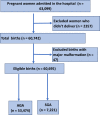Prevalence, risk factors and consequences of newborns born small for gestational age: a multisite study in Nepal
- PMID: 32342014
- PMCID: PMC7173954
- DOI: 10.1136/bmjpo-2019-000607
Prevalence, risk factors and consequences of newborns born small for gestational age: a multisite study in Nepal
Abstract
Objective: To identify the prevalence, risk factors and health impacts associated with small for gestational age (SGA) births in Nepal.
Methods: A cross-sectional study was conducted in 12 public hospitals in Nepal from 1 July 2017 to 29 August 2018. A total of 60 695 babies delivered in these hospitals during the study period were eligible for inclusion. Clinical information of mothers and newborns was collected by data collectors using a data retrieval form. A semistructured interview was conducted at the time of discharge to gather sociodemographic information from women who provided the consent (n=50 392). Babies weighing less than the 10th percentile for their gestational age were classified as SGA. Demographic, obstetric and neonatal characteristics of study participants were analysed for associations with SGA. The association between SGA and likelihood of babies requiring resuscitation or resulting in stillbirth and neonatal death was also explored.
Results: The prevalence of SGA births across the 12 hospitals observed in Nepal was 11.9%. After multiple variable adjustment, several factors were found to be associated with SGA births, including whether mothers were illiterate compared with those completing secondary and higher education (adjusted OR (AOR)=1.73; 95% CI 1.09 to 2.76), use of polluted fuel compared with use of clean fuel for cooking (AOR=1.51; 95% CI 1.16 to 1.97), first antenatal care (ANC) visit occurring during the third trimester compared with first trimester (AOR=1.82; 95% CI 1.27 to 2.61) and multiple deliveries compared with single delivery (AOR=3.07; 95% CI 1.46 to 6.46). SGA was significantly associated with stillbirth (AOR=7.30; 95% CI 6.26 to 8.52) and neonatal mortality (AOR=5.34; 95% CI 4.65 to 6.12).
Conclusions: Low literacy status of mothers, use of polluted fuel for cooking, time of first ANC visit and multiple deliveries are associated with SGA births. Interventions encouraging pregnant women to attend ANC visits early can reduce the burden of SGA births.
Keywords: epidemiology; health service; neonatology.
© Author(s) (or their employer(s)) 2020. Re-use permitted under CC BY. Published by BMJ.
Conflict of interest statement
Competing interests: None declared.
Figures


Similar articles
-
Factors associated with small-for-gestational-age births among preterm babies born <2000 g: a multifacility cross-sectional study in Ethiopia.BMJ Open. 2022 Nov 22;12(11):e064936. doi: 10.1136/bmjopen-2022-064936. BMJ Open. 2022. PMID: 36414292 Free PMC article.
-
Incidence, risk factors and consequences of preterm birth - findings from a multi-centric observational study for 14 months in Nepal.Arch Public Health. 2020 Jul 17;78:64. doi: 10.1186/s13690-020-00446-7. eCollection 2020. Arch Public Health. 2020. PMID: 32695337 Free PMC article.
-
Effect of a scaled-up neonatal resuscitation quality improvement package on intrapartum-related mortality in Nepal: A stepped-wedge cluster randomized controlled trial.PLoS Med. 2019 Sep 9;16(9):e1002900. doi: 10.1371/journal.pmed.1002900. eCollection 2019 Sep. PLoS Med. 2019. PMID: 31498784 Free PMC article. Clinical Trial.
-
Risk of stillbirth, preterm delivery, and fetal growth restriction following exposure in a previous birth: systematic review and meta-analysis.BJOG. 2018 Jan;125(2):183-192. doi: 10.1111/1471-0528.14906. Epub 2017 Oct 3. BJOG. 2018. PMID: 28856792
-
The associations of birth intervals with small-for-gestational-age, preterm, and neonatal and infant mortality: a meta-analysis.BMC Public Health. 2013;13 Suppl 3(Suppl 3):S3. doi: 10.1186/1471-2458-13-S3-S3. Epub 2013 Sep 17. BMC Public Health. 2013. PMID: 24564484 Free PMC article. Review.
Cited by
-
An investigation into the impact of family integrated care on extrauterine growth restriction at discharge in very low birth weight infants: a multi-centre study.J Glob Health. 2025 Aug 11;15:04168. doi: 10.7189/jogh.15.04168. J Glob Health. 2025. PMID: 40785514 Free PMC article.
-
Demographic, socio-economic, obstetric, and behavioral factors associated with small-and large-for-gestational-age from a prospective, population-based pregnancy cohort in rural Nepal: a secondary data analysis.BMC Pregnancy Childbirth. 2022 Aug 19;22(1):652. doi: 10.1186/s12884-022-04974-8. BMC Pregnancy Childbirth. 2022. PMID: 35986258 Free PMC article. Clinical Trial.
-
Factors associated with small-for-gestational-age births among preterm babies born <2000 g: a multifacility cross-sectional study in Ethiopia.BMJ Open. 2022 Nov 22;12(11):e064936. doi: 10.1136/bmjopen-2022-064936. BMJ Open. 2022. PMID: 36414292 Free PMC article.
-
Prognostic factors associated with small for gestational age babies in a tertiary care hospital of Western Nepal: A cross-sectional study.Health Sci Rep. 2021 Feb 15;4(1):e250. doi: 10.1002/hsr2.250. eCollection 2021 Mar. Health Sci Rep. 2021. PMID: 33614985 Free PMC article.
-
Newborn morbidities and care procedures at the special newborn care units of Gandaki Province, Nepal: a retrospective study.BMC Pregnancy Childbirth. 2024 Dec 31;24(1):883. doi: 10.1186/s12884-024-07120-8. BMC Pregnancy Childbirth. 2024. PMID: 39736626 Free PMC article.
References
-
- United Nations Global Strategy for Women’s, Children’s and Adolescent Health Strategy 2016-2030. New York, 2016.
-
- World Health Organization SDG 3: ensure healthy lives and promote wellbeing for all at all ages; 2019. Geneva. Available: https://www.who.int/sdg/targets/en/
LinkOut - more resources
Full Text Sources
